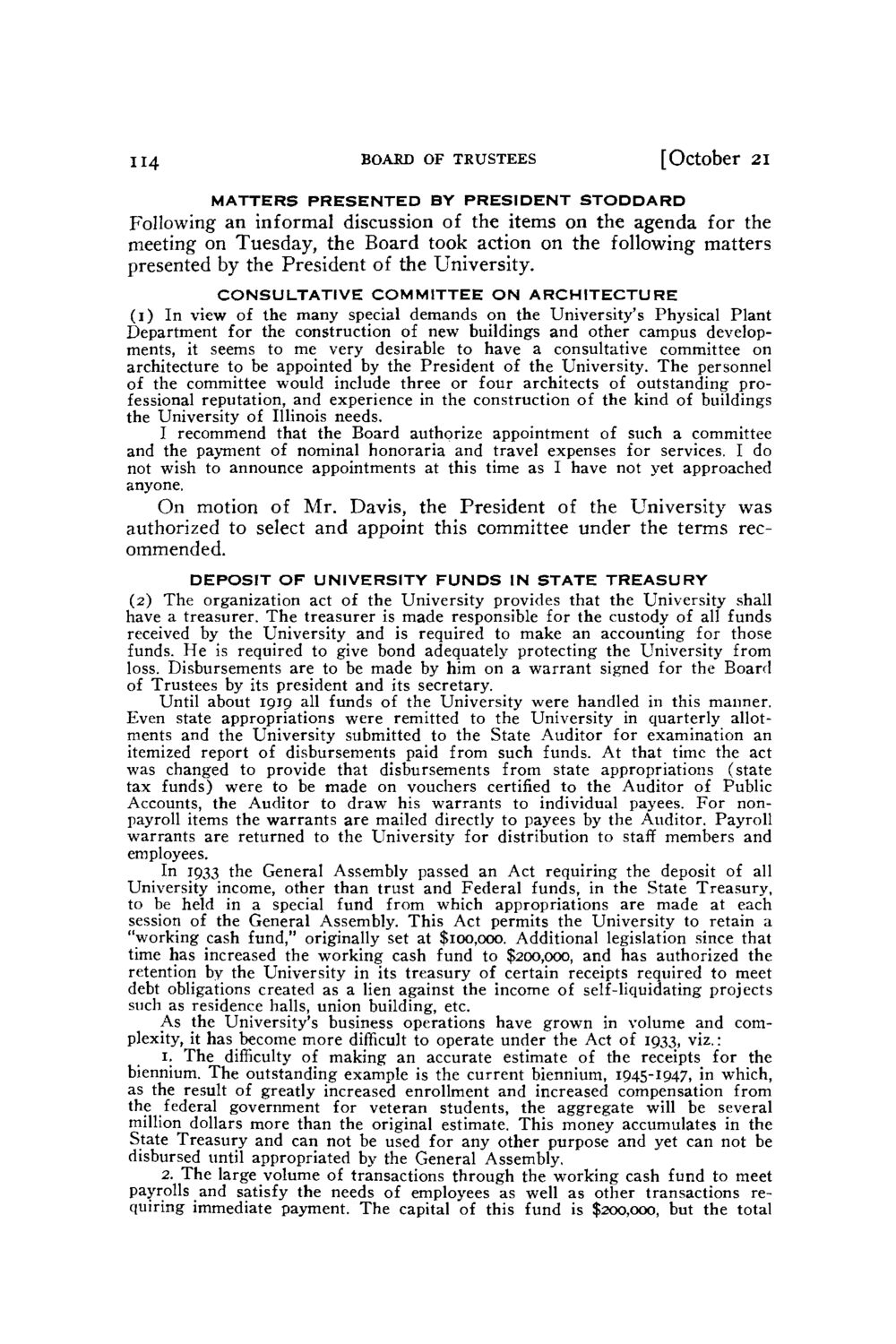| |
| |
Caption: Board of Trustees Minutes - 1948
This is a reduced-resolution page image for fast online browsing.

EXTRACTED TEXT FROM PAGE:
114 BOARD OF TRUSTEES [October 21 MATTERS PRESENTED BY PRESIDENT STODDARD Following an informal discussion of the items on the agenda for the meeting on Tuesday, the Board took action on the following matters presented by the President of the University. CONSULTATIVE COMMITTEE O N ARCHITECTURE (1) In view of the many special demands on the University's Physical Plant Department for the construction of new buildings and other campus developments, it seems to me very desirable to have a consultative committee on architecture to be appointed by the President of the University. T h e personnel of the committee would include three or four architects of outstanding professional reputation, and experience in the construction of the kind of buildings the University of Illinois needs. I recommend that the Board authorize appointment of such a committee and the payment of nominal honoraria and travel expenses for services. I do not wish to announce appointments at this time as I have not yet approached anyone. On motion of Mr. Davis, the President of the University was authorized to select and appoint this committee under the terms recommended. DEPOSIT OF UNIVERSITY FUNDS IN STATE TREASURY (2) The organization act of the University provides that the University shall have a treasurer. T h e treasurer is made responsible for the custody of all funds received by the University and is required to make an accounting for those funds. H e is required to give bond adequately protecting the University from loss. Disbursements are to be made by him on a warrant signed for the Board of Trustees by its president and its secretary. Until about 1919 all funds of the University were handled in this manner. Even state appropriations were remitted to the University in quarterly allotments and the University submitted to the State Auditor for examination an itemized report of disbursements paid from such funds. At that time the act was changed to provide that disbursements from state appropriations (state tax funds) were to be made on vouchers certified to the Auditor of Public Accounts, the Auditor to draw his warrants to individual payees. F o r nonpayroll items the warrants are mailed directly to payees by the Auditor. Payroll warrants are returned to the University for distribution to staff members and employees. In 1933 the General Assembly passed an Act requiring the deposit of all University income, other than trust and Federal funds, in the State Treasury, to be held in a special fund from which appropriations are made at each session of the General Assembly. This Act permits the University to retain a "working cash fund," originally set at $100,000. Additional legislation since that time has increased the working cash fund to $200,000, and has authorized the retention by the University in its treasury of certain receipts required to meet debt obligations created as a lien against the income of self-liquidating projects such as residence halls, union building, etc. As the University's business operations have grown in volume and complexity, it has become more difficult to operate under the Act of 1933, viz.: 1. The difficulty of making an accurate estimate of the receipts for the biennium. The outstanding example is the current biennium, 1945-1947, in which, as the result of greatly increased enrollment and increased compensation from the federal government for veteran students, the aggregate will be several million dollars more than the original estimate. This money accumulates in the State Treasury and can not be used for any other purpose and yet can not be disbursed until appropriated by the General Assembly. 2. The large volume of transactions through the working cash fund to meet payrolls and satisfy the needs of employees as well as other transactions requiring immediate payment. The capital of this fund is $200,000, but the total
| |